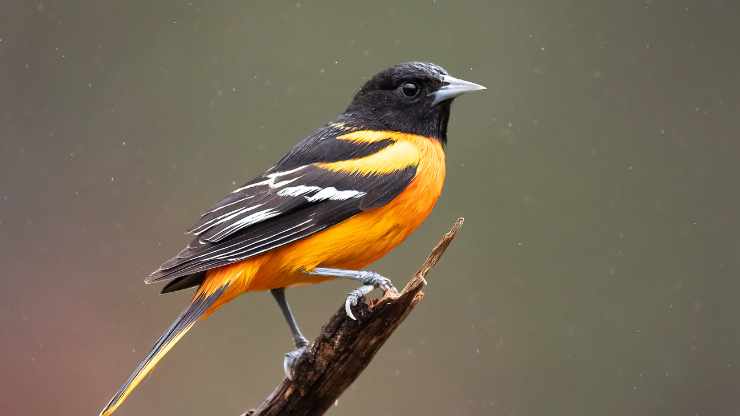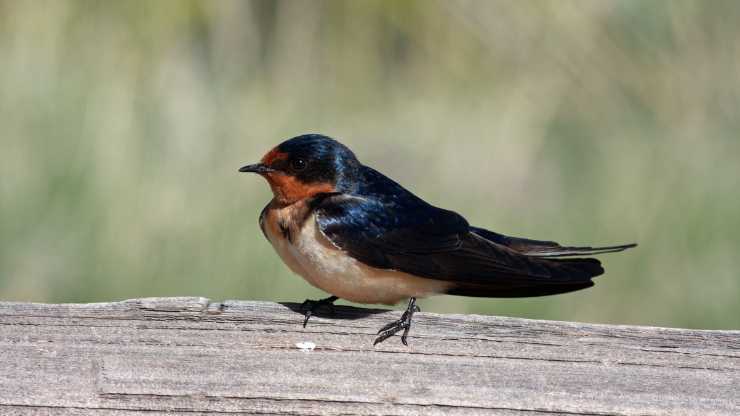Many birders see black birds with an orange belly while they’re on a birding trip and find it difficult to distinguish which species is this.
This article is a full guide where you will find the most black birds with an orange belly, you will distinguish between them easily by pictures and by knowing their names, colors, sizes, and habitats.
Let’s explore these birds and get a general idea about each one and where you can spot it.
1. Baltimore Oriole

Baltimore Oriole (Icterus galbula) is a striking bird with its color, a black head and wings with a white beak and orange belly.
Females, on the other hand, exhibit a more subdued yellowish-orange and grayish-brown plumage.
The order of color and shiny plumage in this bird makes him attractive to birdwatchers.
In terms of size, Baltimore Orioles are medium-sized birds, measuring about 7 to 8 inches in length. They have a wingspan of approximately 9 to 12 inches.
you can primarily find them in deciduous and mixed woodlands, as well as in orchards and gardens. They prefer to build hanging basket-shaped nests, which they weave from plant fibers and other materials in tall trees to protect them from wild animals and birds
During the breeding period, they can be found in Eastern North America, including the northeastern United States and southeastern Canada looking for food resources, nesting sites, climate, and necessary things to succeed in the breeding process.
2. Bullock’s Oriole

Bullock’s Oriole is also found in North America in the western part of the continent.
The males of Bullock’s Oriole have bright orange-yellow underparts, a black throat and face, and a black line extending through the eye.
Their wings and back are black with white wing bars, and their tail is black and orange.
Females have a more subdued appearance with yellowish-orange underparts, a grayish-brown back, and a paler throat.
They are considered also Medium-sized birds and similar to Baltimore Orioles. They measure about 7 to 8 inches in length with a wingspan of 9 to 12 inches.
They prefer to live in open woodlands, riparian areas, and mixed habitats with scattered trees.
If you want to spot them you can go to find them in the western United States, ranging from the Great Basin and Rocky Mountains to the Pacific Coast, as well as into parts of Mexico during the breeding season.
There are migratory birds as they migrate in summer to their breeding grounds in western North America where they find suitable sites for nesting and also to Mexico and Central America in winter.
3. Hooded Oriole

The hooded Oriole is a pretty bird as I have spotted him in the western parts of North America on a birding trip.
When I saw him was in bright yellow plumage with a distinctive black hood covering all of their throat, upper breast, and face. Their wings and tail are also black.
their females are a little different which are yellowish-green plumage, and they don’t have the bold black hood seen in males.
Their length ranges from approximately 7 to 9 inches (18 to 23 centimeters) and a wingspan of about 10 to 12 inches (25 to 30 centimeters), they are also Medium birds.
Everyone who wants to spot this bird should know that they have a variety of habitats, including open woodlands, riparian areas, and suburban gardens. So if you want to see it in your garden or backyard try to put a half-orange cut, it really attracts these birds to come into your bird feeder in your yard.
On another note, these birds are migratory they breed in the southwestern United States in summer and they move into more southern regions or Mexico in winter to find suitable factors to live and breed.
They usually construct their nests in the outer branches of trees as hanging, pendant-shaped from plant fibers, and grasses, they may add their fallen feathers to keep them warm in the difficult and cold climate.
4. Orchard Oriole

The Orchard Oriole is one of the best birds I love to see due to its coloration which displays vibrant colors, featuring a deep chestnut or russet plumage on their body, wings, and tail. Their head is black, and they have a distinct black throat with an orange billy.
females have olive-green to yellowish plumage and a pale throat.
Orchard Oriole is considered one of the small birds, about 6 to 7 inches (15 to 18 centimeters) in length with a wingspan of 8 to 9 inches (20 to 23 centimeters).
This bird is often found in a variety of open habitats, including orchards, gardens, and woodland edges. They are particularly associated with areas that have fruit-bearing trees and shrubs.
They are also migratory birds like the others we mentioned they migrate between their breeding grounds in North America and their wintering grounds in Central America and northern South America. They choose the warmest places in winter and cold places in summer.
They build their nests in tall trees at outer branches of trees also and the form of hanging, pendant-shaped like Hooded Oriole. And I love them for their amazing skills in nest building, they are creative.
5. Altamira Oriole

Altamira Orioles have brilliant golden-orange plumage on their body, wings, and tail.
Their wings may have a slightly darker hue, and they often have contrasting black markings on their face, throat, and upper back. The bill is long and slightly curved, and its eyes are usually dark.
They’re medium-sized birds with a length of 8 to 10 inches (20 to 25 centimeters), and their wingspan is 12 to 14 inches (30 to 36 centimeters).
You can see Altamira Oriole my friend in riparian areas, open woodlands, and coastal scrublands. They are prominently found in specific regions, including southern Texas in the United States, various parts of Mexico, and specific locales in Central America.
As I have seen, they prefer also to construct hanging, pouch-shaped nests using Tree branches, their fallen plumage, plant fibers, and grasses, and I noticed that they use their poop but, maybe to make their nest coherent or because they can’t hold their poop.
the food source of these beautiful birds are fruits, berries, insects, beetles, grasshoppers, crickets, and nectar. So when you see it in your yard try to cut some fruits such as oranges, and put them in your birdfeeder or a tree because they may damage your tree if you don’t provide them with it.
These beautiful birds are migratory also which they travel from wintering grounds to breeding grounds, where they find suitable nesting sites and abundant food resources.
6. American Redstart

American Redstarts are colored with black and bright orange-red patches. They have black wings and tails with vibrant orange-red markings, while the rest of their plumage is black and white.
Their females have olive-green and yellow plumage.
American Redstart is considered from small-sized bird with a length of 4.3 to 5.1 inches (11 to 13 centimeters) and a wingspan of about 6.7 to 7.9 inches (17 to 20 centimeters).
You can find them in summer breeding from the northern United States into parts of Canada, and they migrate to Central and South America in winter to look for suitable conditions for living, less cold, with the availability of food.
They can be found in various habitats during the breeding season including deciduous and mixed woodlands. They may also inhabit shrubby areas, gardens, and second-growth forests.
7. American Robin

American Robin is one of the blackbirds with an orange belly that gives our yards a beautiful touch with their coloration.
They have black wings with an orange billy and chest, their head is black with a white band around their eyes.
their under-tail is white and the beak is orange
Their length is about 9-11 inches (23-28 cm) and a wingspan of approximately 12-16 inches (31-41 cm).
American Robin can be found throughout North America, from Alaska and Canada to Mexico. They are migratory birds, that breed in Canada and the northern United States in summer, and in the winter, If they find it difficult to stay in their current place, they may migrate to the southern United States and Mexico.
You can see this bird in many habitats including lawns, gardens, parks, and shrublands. and woodlands. this bird is Social and not afraid of places with residents.
During the breeding season, they construct their nests in a cup form in tall trees and even you can find it in a tree in your backyard. The female usually lays 3-5 pale blue eggs and incubates them for about 12-14 days.
They love to feed on earthworms, insects, and berries. So if you want to see the American Robin in your backyard you can put on their favorite food and then take a look at your backyard every once in a while.
8. Spotted Towhee

One of the beautiful black birds with an orange belly. Spotted Towhee is known for his black hood and upper body.
They have reddish-brown sides or orange and white spots on its wings.
The eyes are red, and the underparts are generally white. Females are similar but have a brown rather than black hood.
Spotted Towhee is a large sparrow with a length of around 7-9 inches (18-23 cm), with a wingspan of approximately 11-12 inches (28-31 cm).
They can be found in western North America, ranging from southern Alaska to Baja California, they love habitats with dense undergrowth, including chaparral, shrubby areas, and the edges of woodlands.
During the breeding season, male Spotted Towhees sing a beautiful song. They build cup-shaped nests on or near the ground, usually hidden in dense vegetation. The female lays 2-6 eggs, and both parents take turns incubating them for about 12-14 days.
To attract spotted towhee to come to your house you can bring their favorite food which is insects, spiders, seeds, and berries. I personally already did it once and it was successful.
9. Brambling

Bramblings are generally orange as they have a black head and upper body, with a white belly and orange-buff chest. Females and non-breeding males are more brown and buff.
Bramblings are small to medium-sized birds, about 6-7 inches long, with a wingspan of 10-12 inches.
Brambling live in Northern Europe and Asia during breeding and migrate to southern Europe and Asia in winter when the weather is very cold, looking for a warmer place. They love to stay in forests during breeding and open areas like woodlands and farms in winter.
During the breeding season, the male and female build a nest on the ground or in low plants, lay 4-6 blue eggs, and then both parents take turns and help each other to keep the eggs warm for about 11-13 days. and their lifespan is 2 to 12 years.
To attract Brambling, If it’s in the winter season you can get out to your yard only some beech mast, birch seeds, or weed seeds. and if you find some insects and larvae are also part of their diet it will bring many other species. and this is a good thing to do.
10. Scarlet Tanager

Scarlet is a beautiful bird with an amazing color that makes you love it like me from the first look.
they have red or orange color over all of their body including, the head, chest, and belly with black wings and tail,
This bird is considered also a medium-sized bird with a length of 6.3-6.7 in (16-17 cm) and a wingspan of around 9.8-11.4 in (25-29 cm).
This bird likes to stay and live in forests far away from humans and rarely can be found in backyards, this is what makes him to spot for birdwatchers.
they breed in eastern North America and migrate to northern South America during the winter, if someone decides to spot them, I advise you my friend to look for them in large and open spaces in forests.
their nests are also cup-shaped, So the females build it during the breeding season in a tree, and always they prefer to build it in high trees to be difficult for rioters, wild birds,
and animals to reach.
They are primarily like to feed on insects and fruits. During the breeding season, their diet includes caterpillars, beetles, and other invertebrates, while in the winter, they rely more on fruits and berries.
11. Flame-colored Tanager

bright orange-red, and females are more subdued with yellow-green feathers. Their wings and tail are black.
They’re medium-sized birds with 7 inches long, and a wingspan of around 10 inches.
Their range includes parts of Central and South America, Mexico, and Venezuela. They like to stay in mountainous areas, especially in forests with a mix of trees.
During breeding, these tanagers form pairs. The female builds a cup-shaped nest in a tree, laying 2-4 eggs. Both parents take turns keeping the eggs warm for about 13-14 days.
They usually build their nests high up in trees for safety. Chicks leave the nest around 14-18 days after hatching, and both parents continue to care for them.
they love to feed on a variety of insects and fruits. They often forage in trees, searching for insects including Caterpillars, Beetles, True, and Ants, and enjoy fruits and berries as part of their diet.
12. Varied Thrush

These beautiful creatures really make me love nature and my environment with their color.
Varied Thrush has deep blue-black and bright orange hues for males. The male has black wings and a tail, accompanied by orange in his underparts including chest and belly.
Females have a grayish-brown plumage and a less prominent eyeline.
Varied Thrush is a medium-sized bird with a length around of 7.5-10.2 inches (19-26 cm), and a wingspan of 13.4-15.0 inches (34-38 cm).
If you want to spot them by traveling my friend you can find them in western North America, regions from Alaska through the coastal areas of British Columbia, Washington, Oregon, and into northern California.
They prefer to live in coniferous forests, especially forests where there are many hemlock and spruce trees. They prefer areas with dense undergrowth and are often located near streams or wetter environments. In winter, they may also inhabit more open woodlands and gardens.
They don’t love to stay in places where there is a lot of popularity, so this is why they prefer to live in forests or near the rivers.
The females of Varied Thrush in breeding season construct cup-shaped nests using twigs, moss, and leaves. in high trees to protect themselves from wild birds and animals or even humans.
They primarily feed on insects, spiders, and other invertebrates. you can rarely see them in your backyard, unfortunately, because as we already mentioned they are not social birds.
13. Western Bluebird

The Western Bluebird is a different bird from those we already mentioned.
The general color of this bird is blue, which makes it look beautiful and adds a good touch to nature.
They have an orange chest and belly and those colors blue and orange are really amazing my friend.
Their size is medium which they have a Length of 6.3-7.5 in (16-19 cm), and a wingspan of 11.4-13.4 in (29-34 cm).
They are native to western North America and can be found from southern Canada to Baja California and eastward to the Rocky Mountains.
Western Bluebirds prefer open habitats with scattered trees and ample perching sites. They are commonly found in meadows, grasslands, and orchards.
They love to feed on a variety of insects such as beetles, grasshoppers, and caterpillars. So if you want to see them in your backyard someday, you can put one of their favorite die in your birdfeeder and wait.
14. BARN SWALLOW

Barn swallows have a black back, tail, wings, and head with brown to orange belly, chest, and neck.
Their color is beautiful, and their size is 5.9-7.5 in (15-19 cm), and a wingspan of 11.4-12.6 in (29-32 cm).
Barn swallows a migratory birds, so they have a wide range and you can find them anywhere. they can be found breeding in the Northern Hemisphere and winter in the Southern Hemisphere. Their range spans from North and South America to Europe, Asia, and Africa.
These birds are capable and can live in any place even if it is near humans, as you can find guys in barns, bridges, and open sheds.
They have pretty good hunting skills and they feed primarily on insects such as mosquitoes, flies, moths, and beetles.
15. Say’s Phoebe

Say’s Phoebe is generally a grayish bird with a back, wings, tail, and head with an orange belly.
the size of this Phoebe is 6.7 in (17 cm) in length and a weight of 0.7-0.8 oz (21-22 g).
These Phoebe can be found in western North America, and inhabit regions from the southwestern United States into Mexico and parts of Central America. They are commonly seen in arid and semi-arid landscapes.
they like to live in deserts, grasslands, and agricultural areas. They often perch on fences or elevated structures to spot flying insects.
Phoebies love to eat flying insects like flies, beetles, and moths, I respect them for their amazing hunting skills hahaha.
